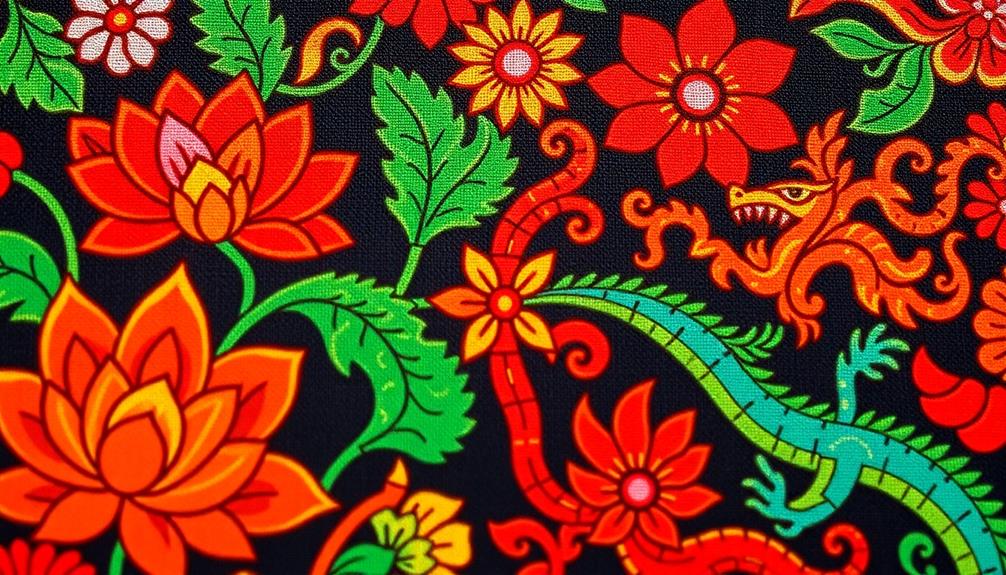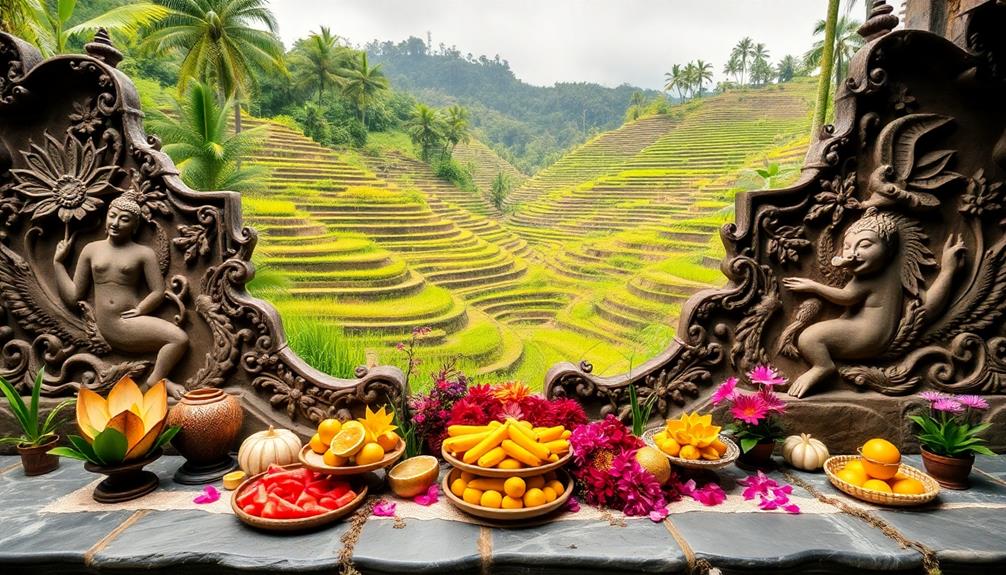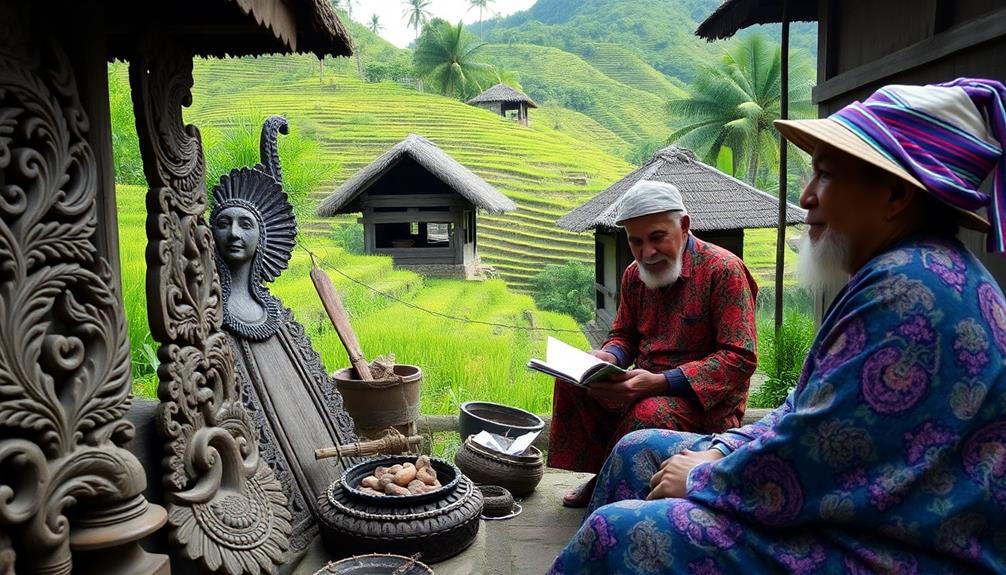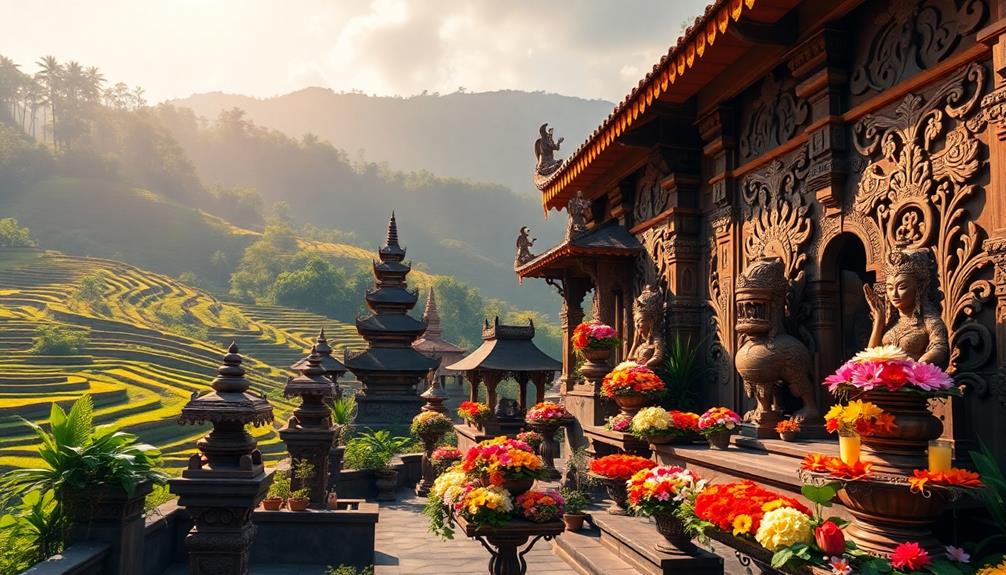Balinese design motifs vividly represent the culture by intertwining elements of nature, spirituality, and daily life. For instance, the Singa Barong motif symbolizes protection and strength, while floral patterns like Bali Buketan express beauty and interconnectedness. These designs also reflect the Balinese philosophy of Rwa Bhineda, highlighting balance and duality. Motifs often draw inspiration from the island's rich biodiversity, showcasing marine life and landscapes. Every pattern carries a story, rooted in folklore and traditional values. By exploring these motifs, you can uncover deeper connections between art and the vibrant Balinese culture that continues to thrive today.
Key Takeaways
- Balinese design motifs symbolize protection and strength, particularly represented by the Singa Barong motif in cultural practices and rituals.
- Floral patterns like Bali Buketan express the beauty of nature and interconnectedness within the community and environment.
- Textiles, especially batik, feature intricate designs reflecting spiritual beliefs and cultural narratives, enhancing their significance in Balinese life.
- Nature is a central influence on motifs, capturing Bali's biodiversity and sacred landscapes through vibrant colors and intricate details.
- Spiritual symbolism, such as the lotus flower representing purity, highlights the deep-rooted Hindu beliefs embedded in Balinese art and architecture.
Cultural Significance of Design Motifs

Balinese design motifs hold an essential role in the island's cultural landscape, intertwining elements of nature, spirituality, and daily life. You'll find that each motif reflects the rich tapestry of Balinese culture, representing the community's beliefs and practices.
For instance, the Singa Barong motif symbolizes protection and strength, while floral patterns like Bali Buketan express beauty and the interconnectedness of life. These motifs are often mirrored in traditional artifacts, such as Indonesian decor masks, which enhance the aesthetic appeal and cultural representation within homes.
These intricate designs aren't just visually appealing; they carry deep cultural significance. They often serve as visual representations of Balinese philosophies, such as Rwa Bhineda, which emphasizes the balance and harmony between opposites in life.
When you wear traditional Balinese attire adorned with these motifs, you're not just dressing up; you're participating in rituals and ceremonies that reinforce community identity and spiritual connections.
Moreover, the vibrant colors and patterns found in textiles like batik tell stories of the island's history and traditions, creating a sense of belonging.
Symbolism in Balinese Textiles

Textiles from Bali aren't just fabric; they're vibrant stories woven with cultural significance. Balinese textiles, especially batik, feature intricate motifs that reflect the island's rich culture and spiritual beliefs. Each design carries deep symbolism, revealing aspects of daily life and the natural world around you.
For instance, the Singa Barong motif symbolizes protection and strength, while the Balinese Dancers motif showcases the island's thriving performing arts heritage. Additionally, Indonesian decorative pillows often incorporate similar patterns, enhancing living spaces with cultural narratives.
You'll find that each batik pattern tells a unique story. The Ulamsari Mas motif, for example, depicts marine life, highlighting Bali's close relationship with the sea.
Additionally, the vibrant colors and intricate designs represent the philosophy of Rwa Bhineda, emphasizing balance and harmony between opposites in Balinese culture.
Even simpler motifs, like those of dragons and turtles, convey important messages—strength, wisdom, and protection—rooted in local folklore.
Nature's Influence on Motifs

Motifs in Balinese design vividly capture the island's natural beauty and biodiversity. Nature's influence on motifs is evident throughout Bali culture, where elements like flowers, animals, and marine life are woven intricately into textiles and art. The Balinese people celebrate their environment through designs such as the Bali Buketan, which showcases floral patterns complemented by butterflies and bees, symbolizing nature's beauty and essentiality.
This appreciation for nature is also reflected in traditional craftsmanship, as seen in unique pieces like the Indonesian Decor Mask that embody cultural heritage.
Another prime example is the Ulamsari Mas motif, which features fish and shrimp. This highlights the significance of marine life, not only for sustenance but also for its spiritual role in the community. Many batik designs draw inspiration from Bali's landscapes, representing sacred temples and natural elements, illustrating the harmony between humanity and nature.
The vibrant colors used in these motifs enhance their aesthetic appeal and reflect the liveliness and richness of Bali's surroundings. Each design tells a story that embodies the Balinese way of life, emphasizing the deep connection between the people and their environment.
Through these motifs, you can see how nature profoundly shapes Balinese art and culture, celebrating the island's unique identity.
Spiritual Connections in Art

In the rich tapestry of Balinese art, numerous spiritual symbols and themes intertwine, reflecting the island's deep-rooted Hindu beliefs. You'll find that Balinese design motifs often incorporate elements that forge strong spiritual connections, bridging the gap between the physical and spiritual domains.
For instance, the lotus flower symbolizes purity and enlightenment, representing the soul's journey in Balinese spirituality. This emphasis on natural materials like wood and stone further enhances the spiritual essence of the designs, as these elements are considered to embody the earth's energy.
When you explore batik patterns, you'll notice the depiction of animals and mythical creatures like the Barong. These figures embody protective spirits, serving to ward off negative energies and fostering a sense of safety in the community.
The intricate carvings and designs of temple architecture not only beautify the structures but also narrate sacred stories and religious teachings, helping to keep Balinese culture and traditions alive.
Moreover, the philosophy of Rwa Bhineda, emphasizing balance and duality, manifests in various artistic motifs, showcasing the harmonious relationship between opposing elements in life and spirituality.
Through these elements, you can truly appreciate how Balinese Hinduism permeates art, enriching the spiritual connections that define the island's identity.
Preservation of Traditional Values

Balinese art not only showcases spiritual connections but also plays an essential role in preserving traditional values. Through intricate designs, the community maintains a deep bond with their environment, emphasizing the philosophy of Tri Hita Karana. This connection is evident in the motifs you see around, often inspired by nature, such as rice fields and bamboo poles, which symbolize sustenance and strength.
Additionally, the vibrant colors and patterns found in these artworks often reflect the rich storytelling aspect of Indonesian decor masks, adding depth to their cultural significance.
In Balinese culture, every design tells a story, often linked to important events or folklore. By integrating these motifs into ceremonies, the community guarantees that values are passed down through generations.
Here are some key aspects of this preservation:
- Symbolism of Protection: Motifs like the Singa Barong represent strength and guardianship.
- Ceremonial Importance: Colors and designs in offerings reflect respect for the divine and ancestors.
- Cultural Continuity: Practices involving traditional art foster community bonds and collective identity.
Even architectural elements, designed for natural ventilation, reflect these values, emphasizing harmony with nature.
This commitment to cultural heritage enriches daily life and strengthens the Balinese identity, guaranteeing that traditional values live on vibrantly.
Frequently Asked Questions
What Are the Cultural Values of Bali?
In Bali, you'll find cultural values emphasizing harmony, community, and spirituality. You'll experience daily devotion through offerings, witness vibrant festivals celebrating life's dualities, and appreciate architecture reflecting a deep connection to nature and heritage.
What Is the Meaning of Balinese Carvings?
Balinese carvings convey rich spiritual beliefs and cultural identity. You'll notice they depict mythological creatures and nature, symbolizing harmony and balance while enhancing architectural spaces, reflecting the community's connection to their traditions and environment.
What Is the Balinese Architecture Culture?
As the saying goes, "Home is where the heart is." In Balinese architecture, you'll see harmonious designs that connect with nature, reflecting community values and spirituality, where family compounds create a sense of belonging and balance.
What Is the Purpose of Balinese Art?
Balinese art serves to express spirituality, embody cultural narratives, and enhance ceremonies. You'll find that it reflects the community's identity, promotes harmony, and connects deeply with the island's rich traditions and Hindu beliefs.
Conclusion
In the vibrant tapestry of Balinese design, each motif whispers stories of culture, nature, and spirituality. As you explore these intricate patterns, you're not just observing art; you're stepping into a world where every thread is woven with meaning. Imagine walking through lush rice paddies, where the colors and shapes of the landscape inspire the designs, reminding you that tradition and nature are forever intertwined. Embracing these motifs means embracing the heart and soul of Bali.










